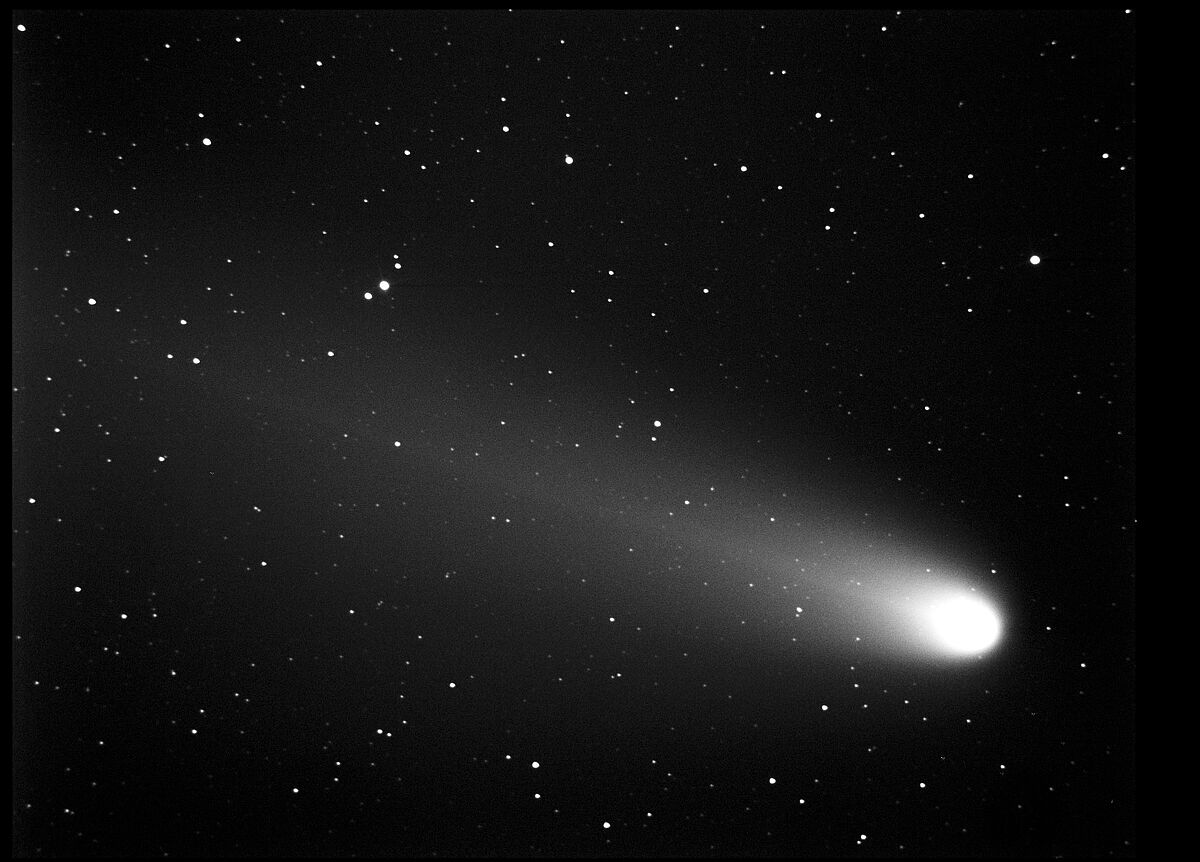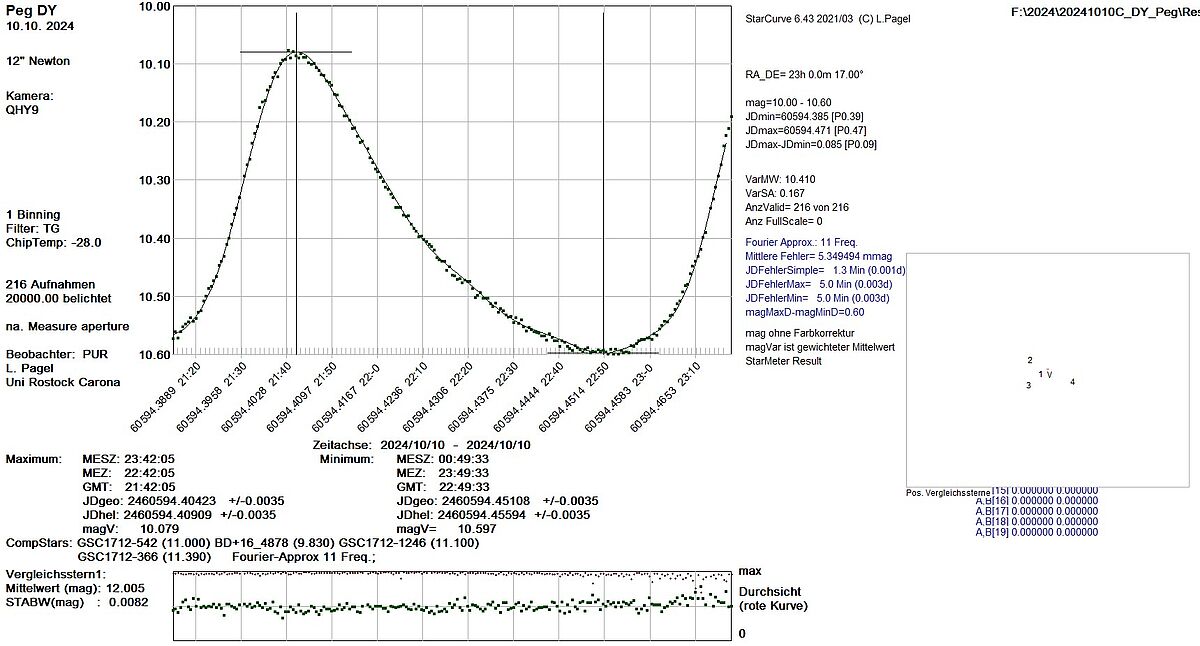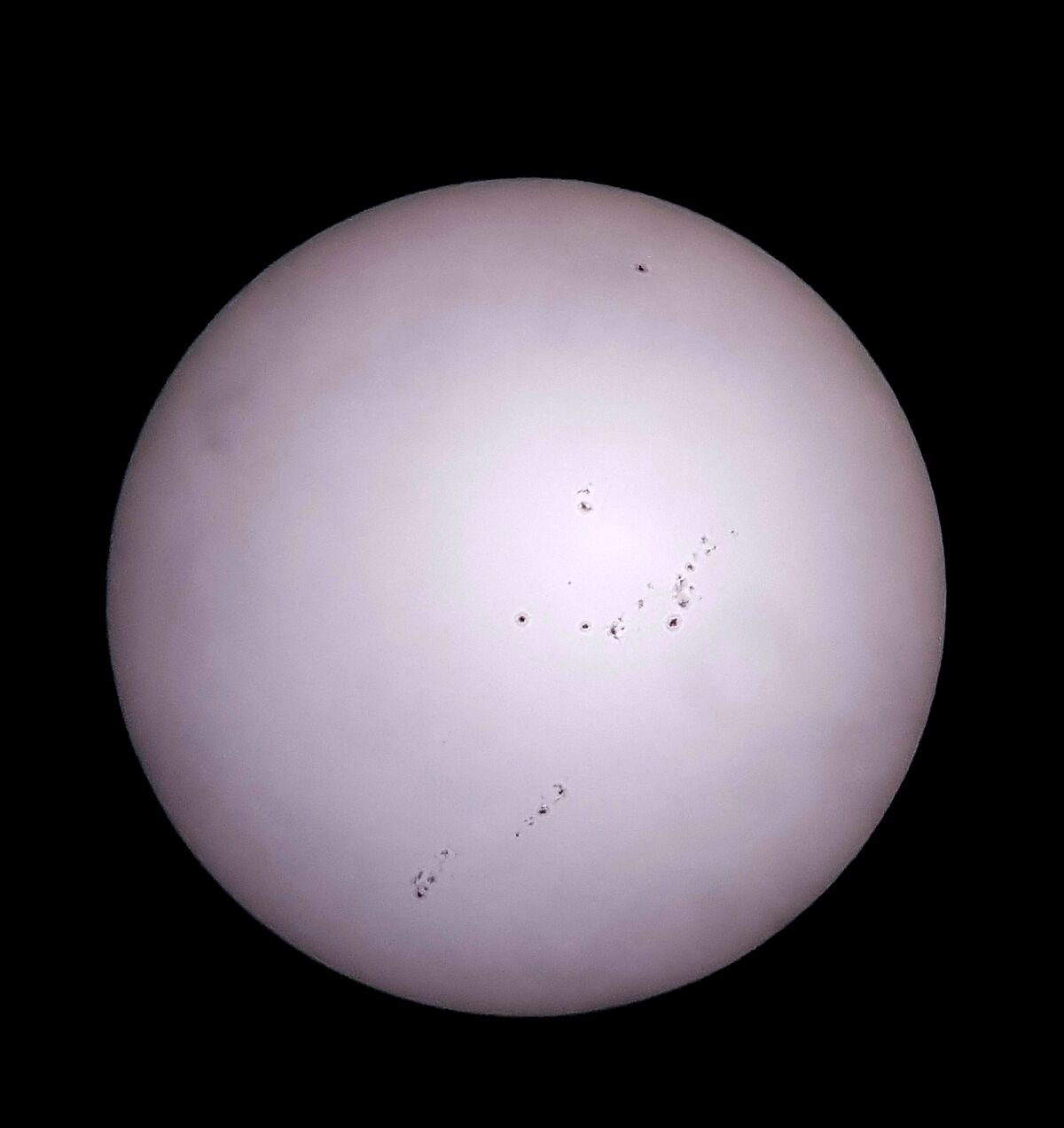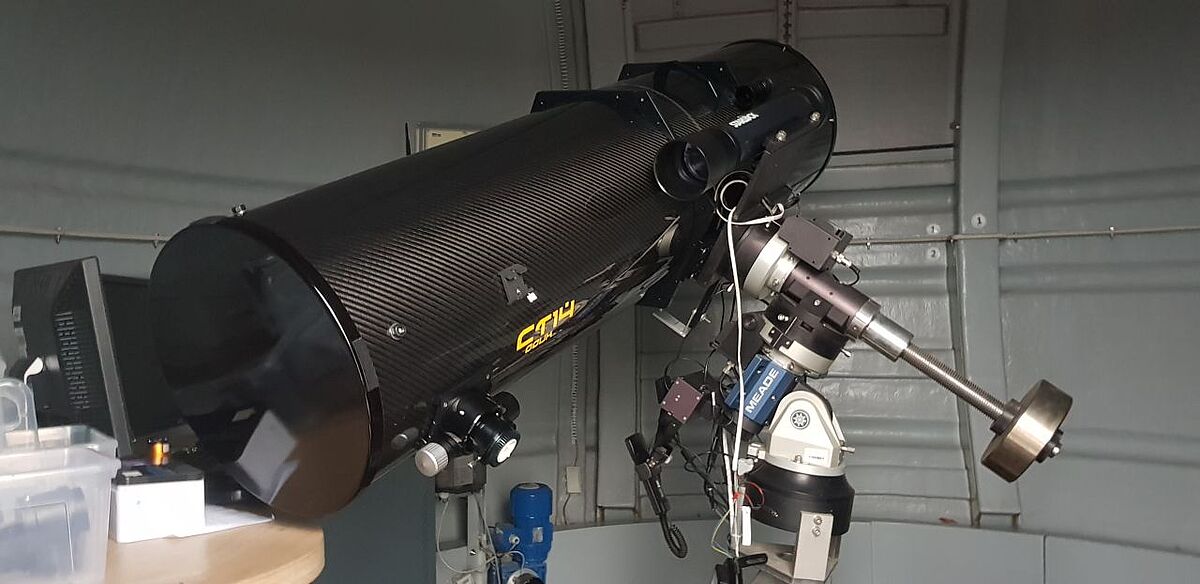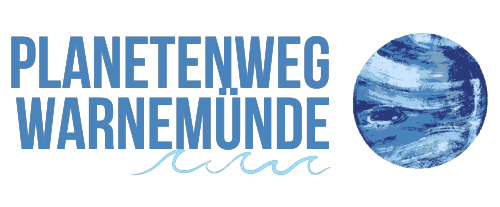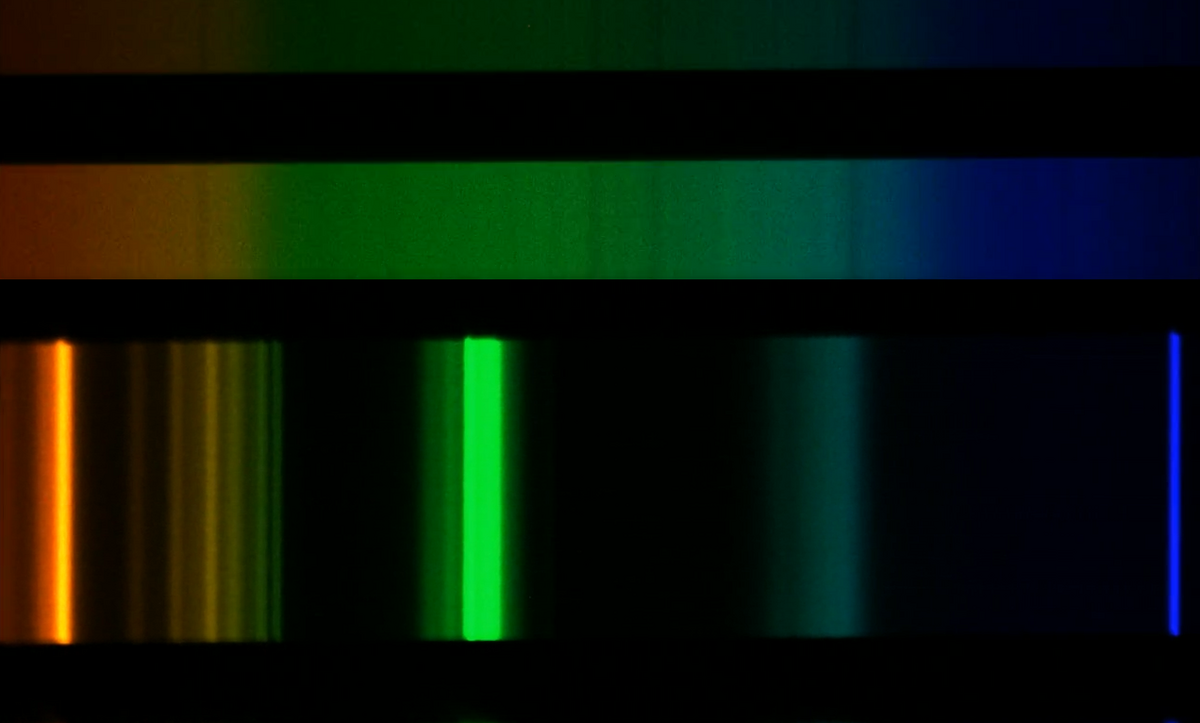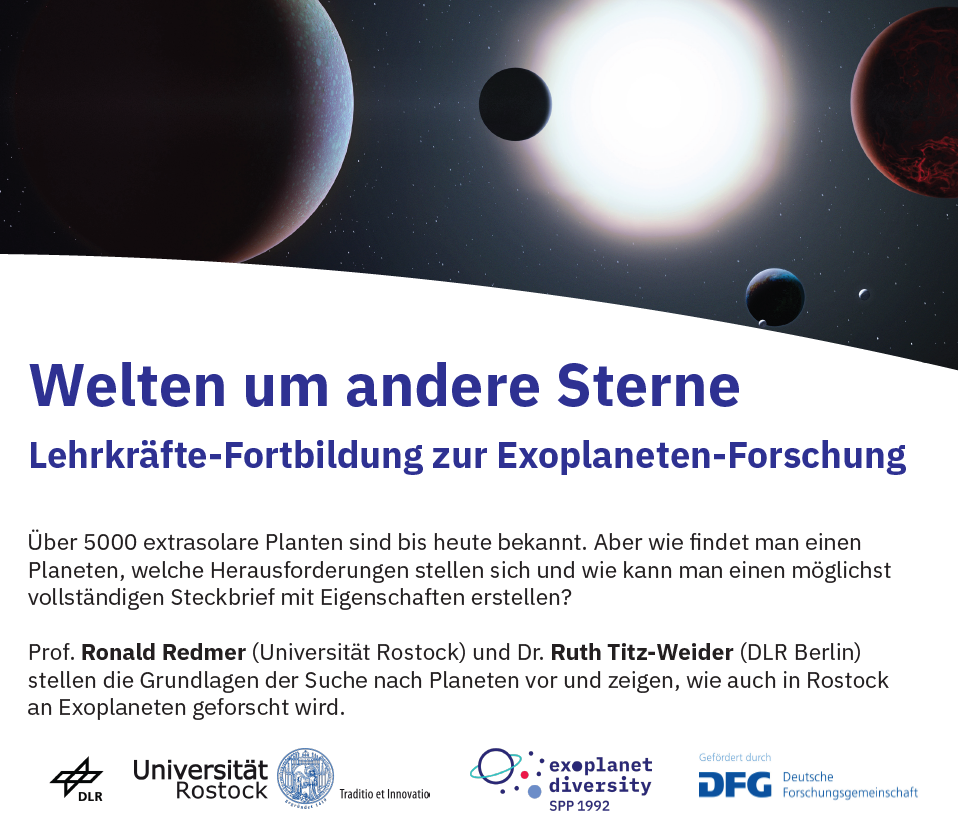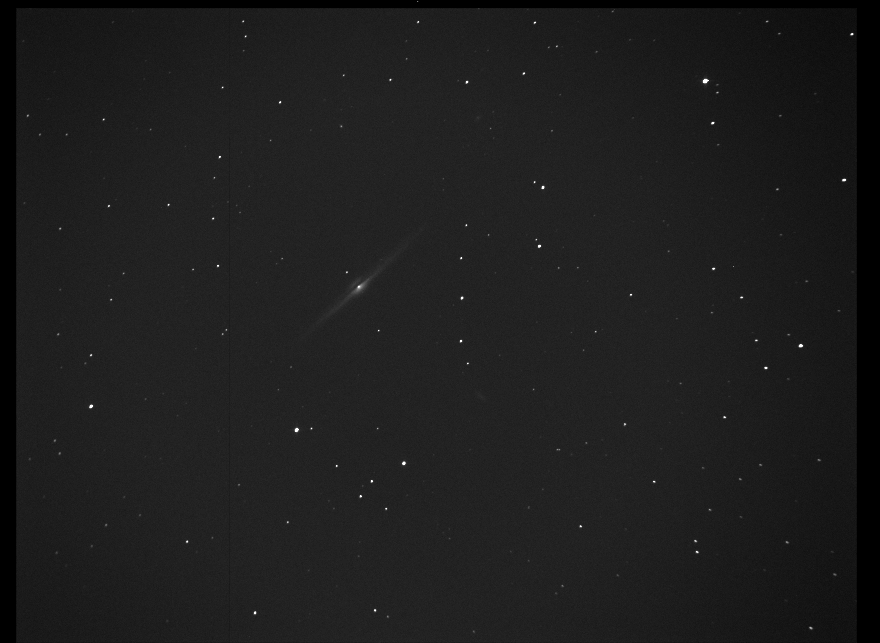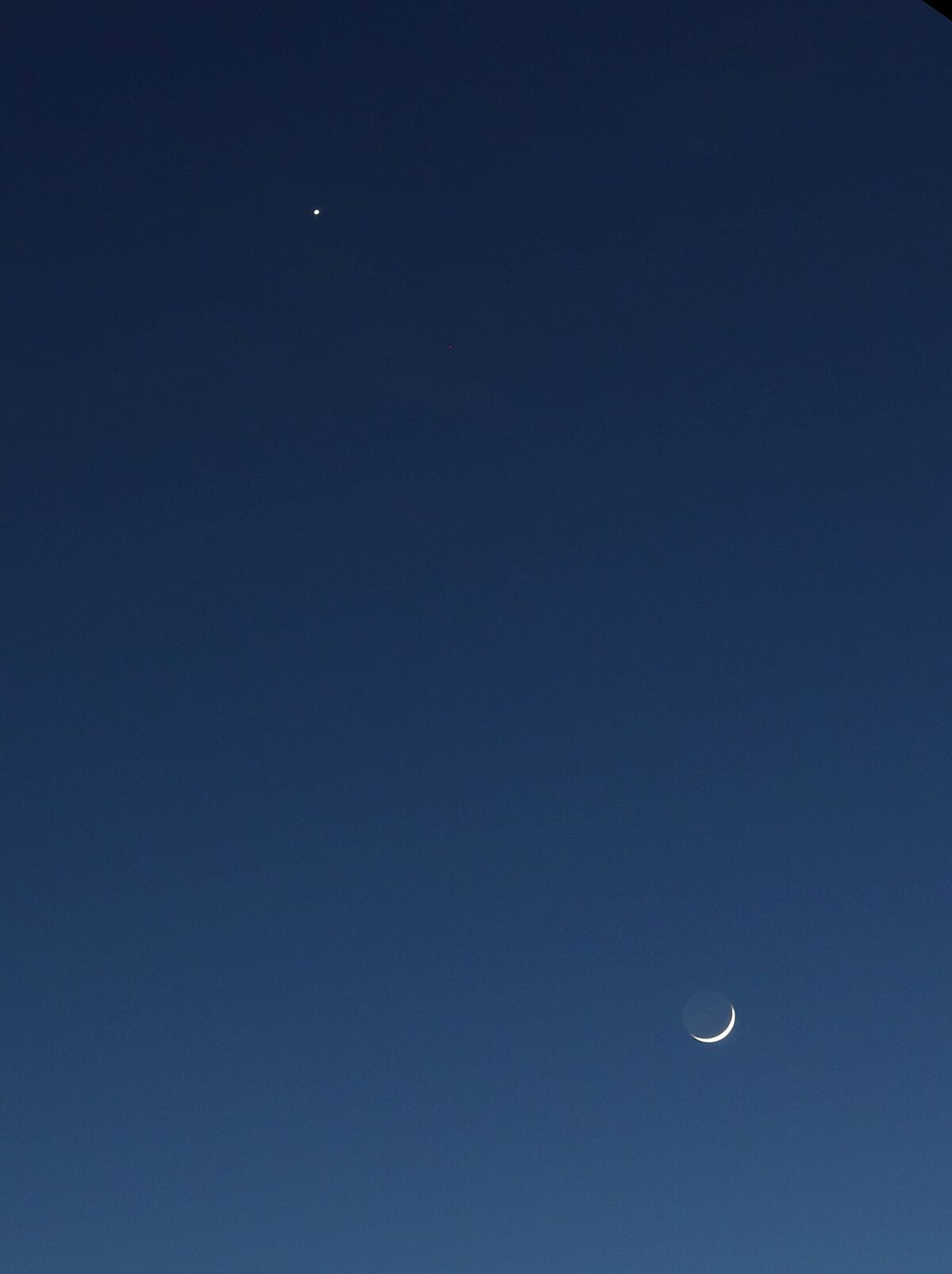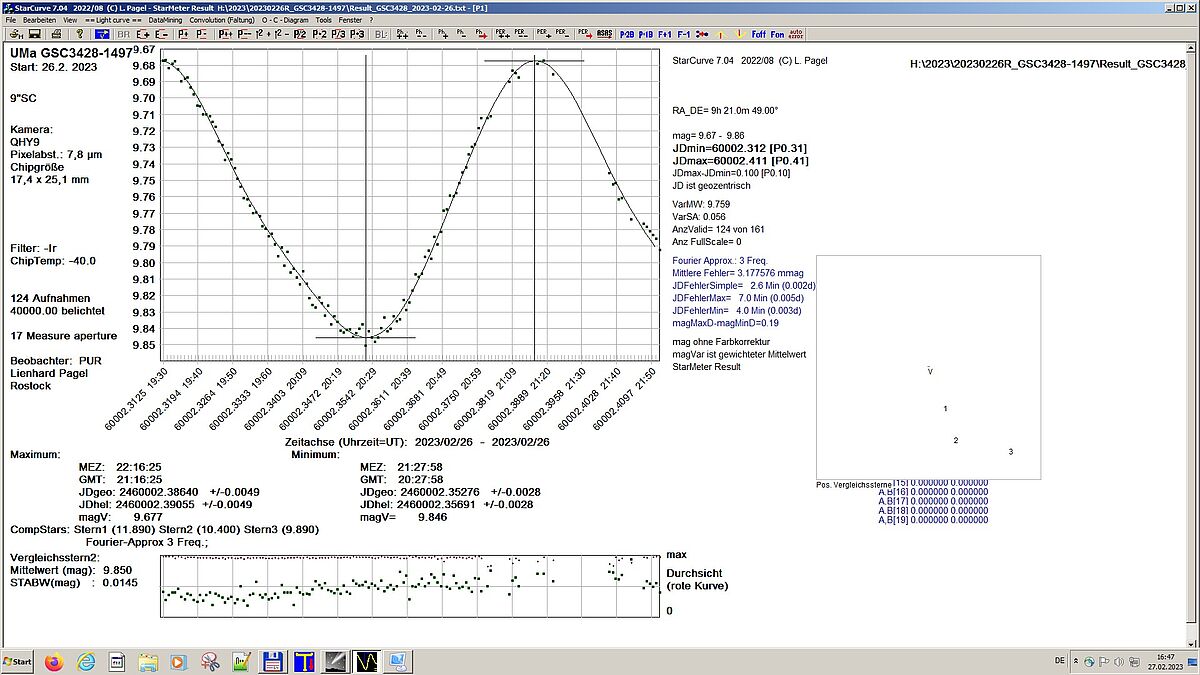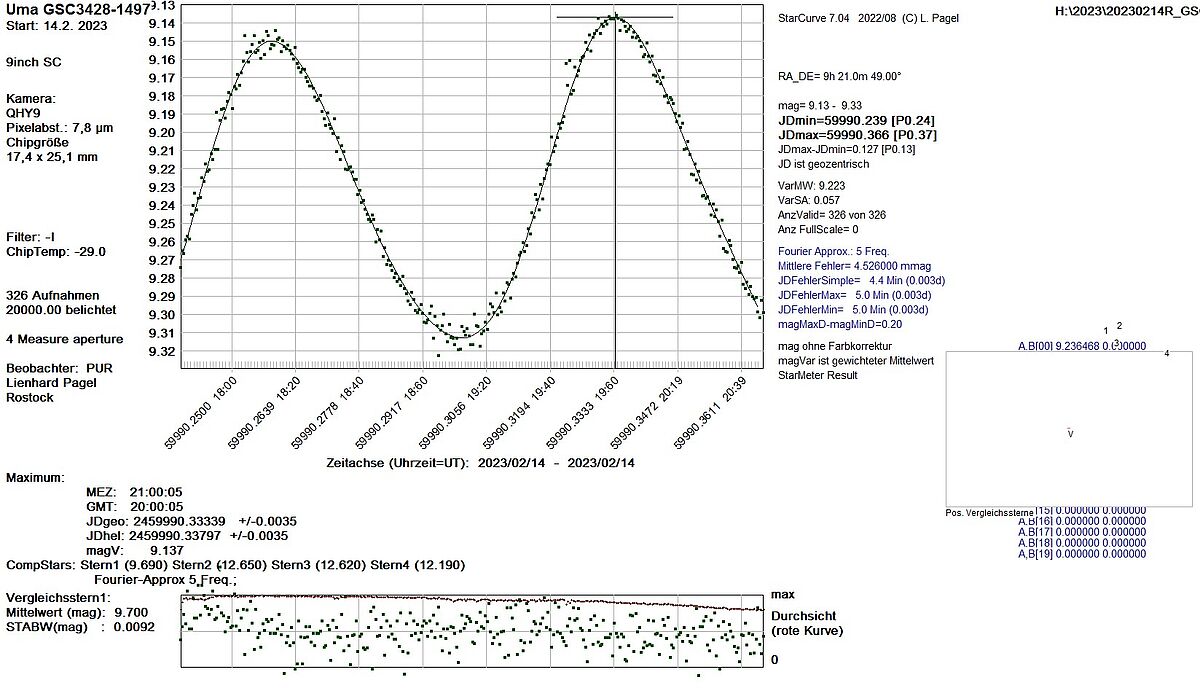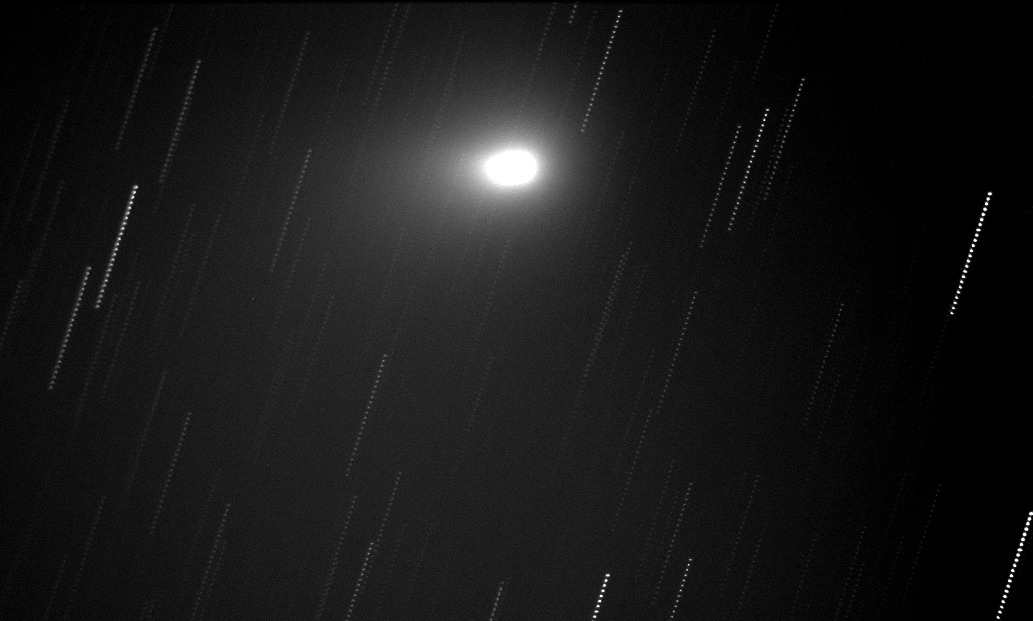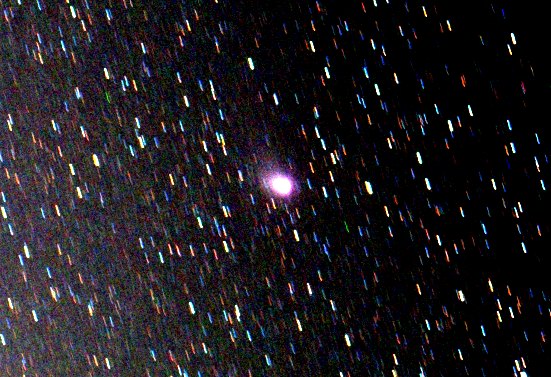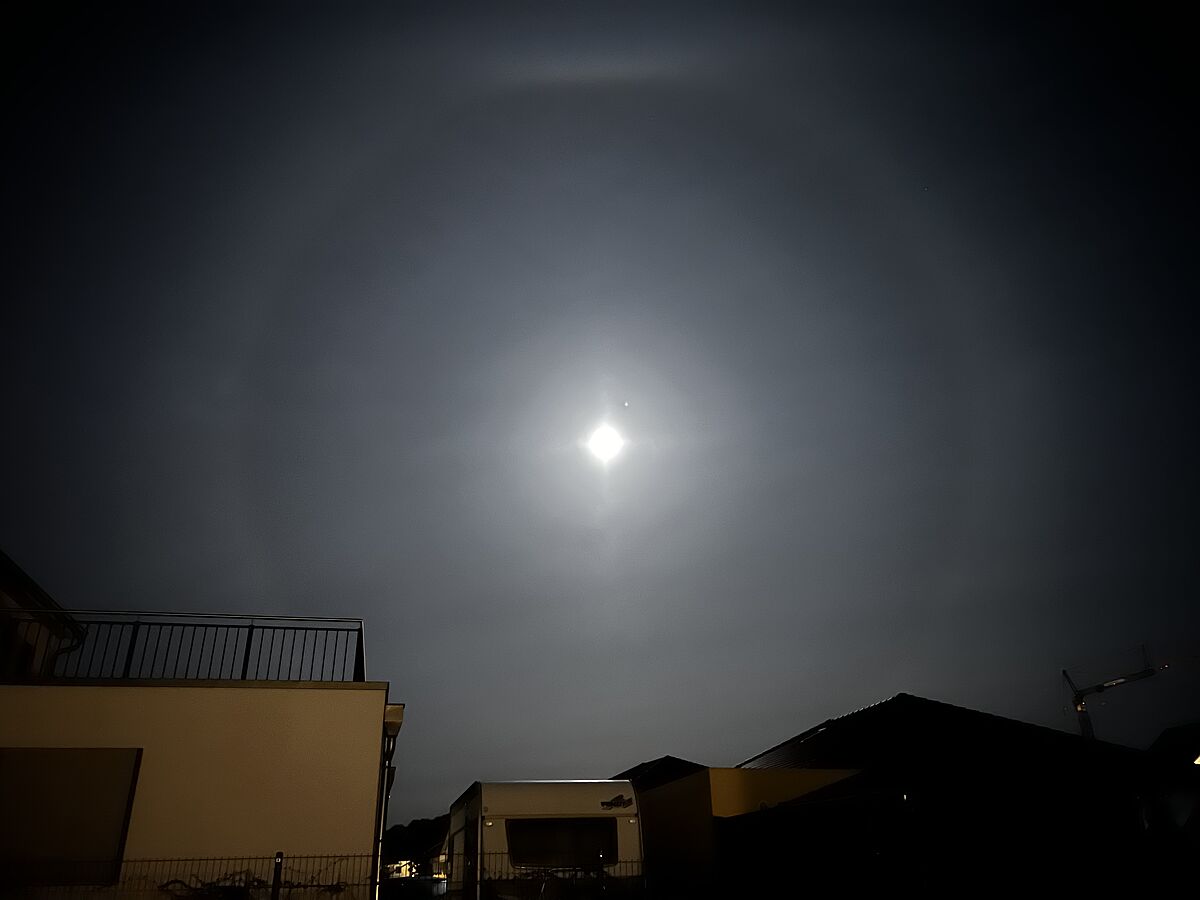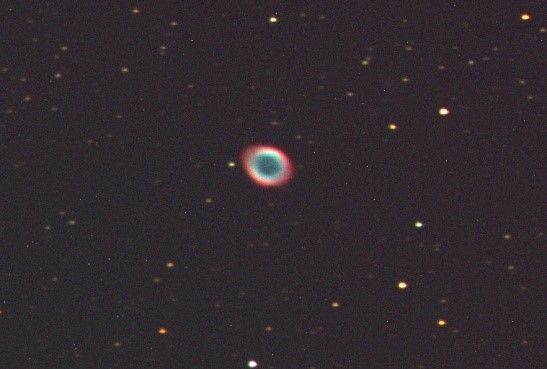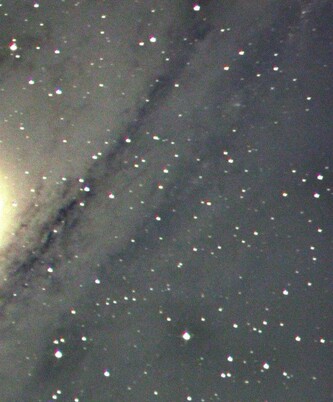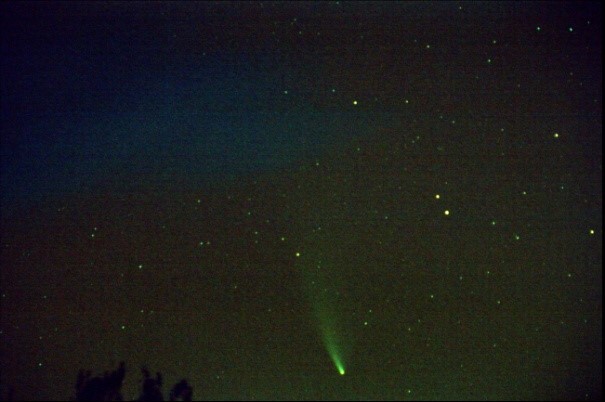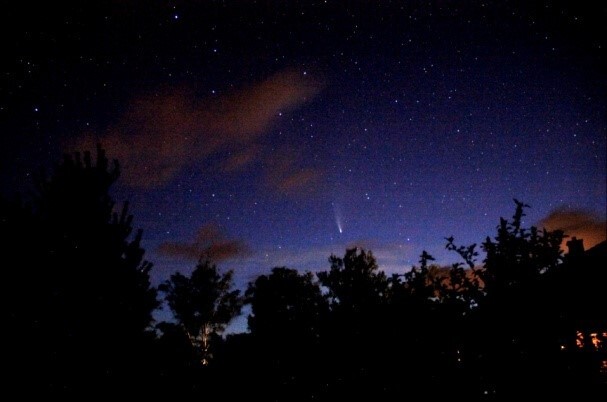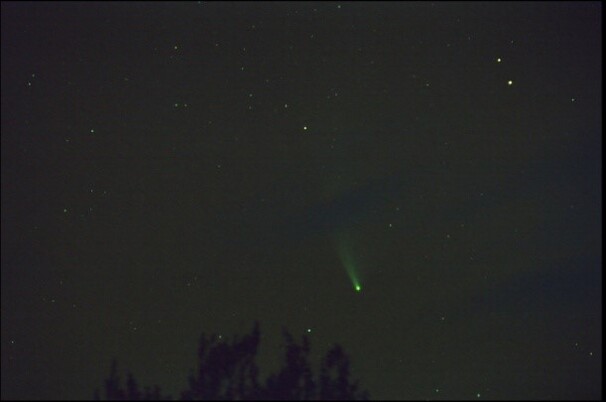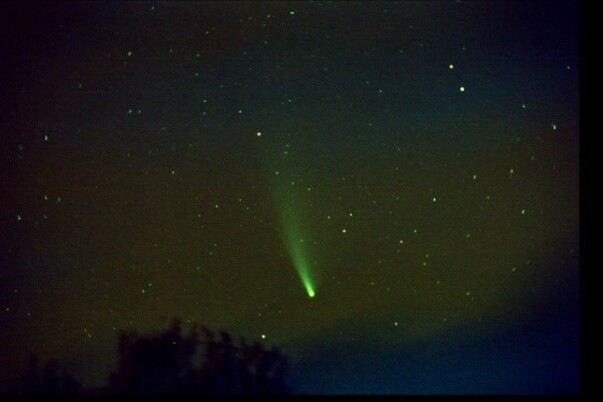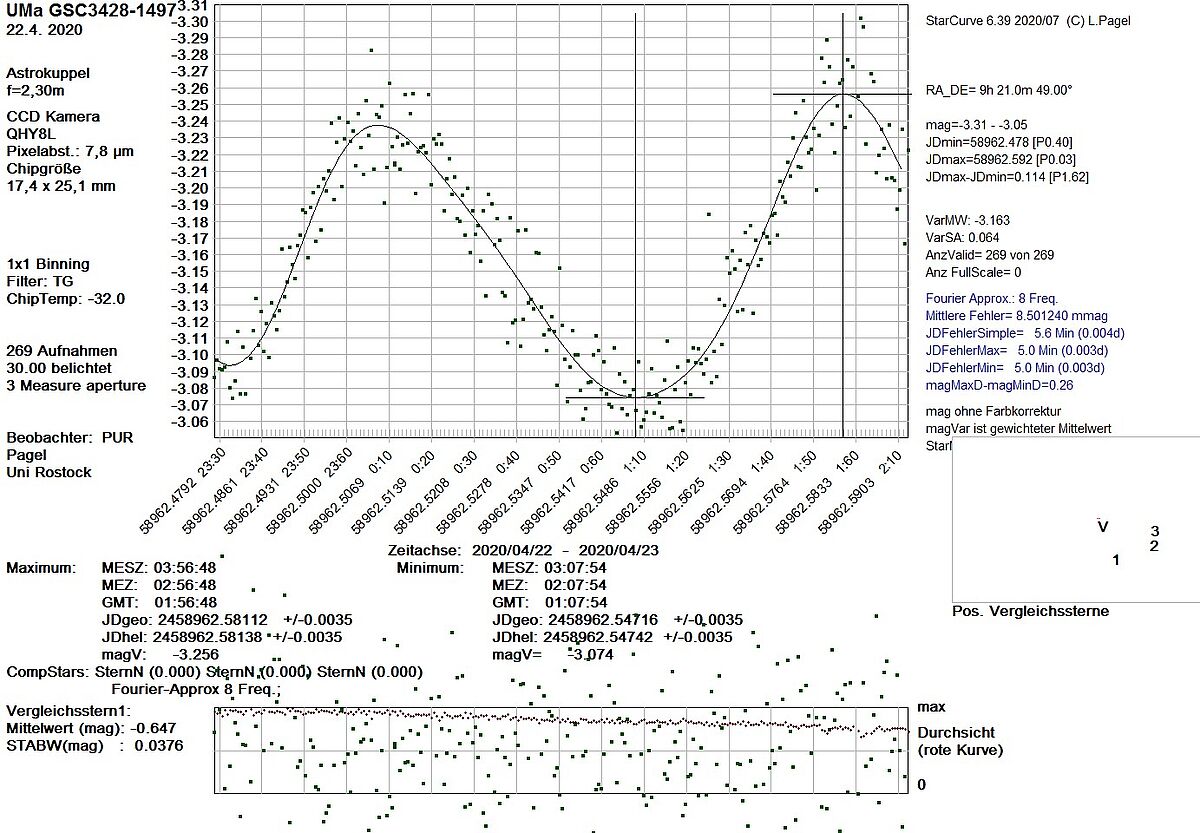
2024-10-24: Comet C/2023 A3 Tsuchinshan-ATLAS
Observer: Andreas Schulz
Telescope: Astrokuppel
Before Tsuchinshan-ATLAS once more heads off into the dark expanse of the outer solar system, we took this farewell picture. In October, this comet was visible to the unaided eye, at times even during dawn or dusk - when the local weather did not get in the way. With a magnitude reaching -4, this exceptional comet was the third-brightest one in a century.
2024-10-10: Light curve of DY Pegasi
Observer: Lienhard Pagel
Telescope: 12'' Newton (Carona)
Camera: QHY9
After an eventful spring and summer, our alpine outpost is once more operational. Following a lightning strike that took out some of the electronics, two inadvertent collisions with the roof of the Carona observatory also caused mechanical damage. With the completion of the necessary repairs and realignment, DY Pegasi served as target for our first quantitative observations. The brightness of this variable star oscillates with a period of approximately 1.75 hours.
2024-07-29: A new pillar for Astrokuppel
Since its installation, our new 14'' Newton telescope has given its mount and stand a hard time. In order to accommodate the larger and heavier tube without running afoul of the maximum loads as well as to suppress undesirable vibrations, we worked together with the institute's machine shop to design a sturdier replacement for the existing stand. Constructed by the team of Paul Voss, the new setup is not only aesthetically pleasing, but also provides the necessary solid ground for the large-caliber telescope.
2024-07-28: Sunspots
Observer: Andreas Schulz
Telescope: 4" f10 Maksutow + smartphone camera
The sun currently approaches the maximum of its 11-year activity cycle. This phase is characterized by a particularly frequent occurrence of sunspots, as was visible today. The sun's activity also affects the direct vicinity of Earth: In May of this year, a series of large coronal mass ejections caused the strongest geomagnetic storm in several decades.
2024-01-04: New Telescope in the Institute's Observatory
The New Year brings a significant upgrade: The trusty 9-inch Schmidt-Cassegrain telescope of the institute's observatory is being replaced by a 14-inch Newton telescope. Capable of collecting approximately 2.4x more light than its predecessor, it will significantly improve our photometric capabilities. Until first light, some modifications will have to be made to the existing mount to accommodate the significantly larger barrel dimensions of our newest piece of equipment.
2023-09-30: First Planetary Run
On September 30, 2023, the first Planetary Run will take place in Rostock-Warnemünde. Earlier this year, a team of students from the Institute of Physics won funding for the refurbishment of the Warnemünde Planetary Hiking Trail at Hochschulwettbewerb 2023. During this inaugural event hosted by the University of Rostock and the Astronomische Verein Rostock e. V., the runners will pass the modernized stations of the trail.
Startig Times:
3K run: 10:00
8K run: 10:30
Hike (3K) from "Sun" to "Saturn": 12:30
Joint award ceremony: 12:00
Short talks on planets and astrophysics at Institute for Baltic Sea Research: 14:30–16:00
Contact:
Philipp May
University of Rostock
Institute of Physics
Phone: +49 381 498-6935
philipp.may(at)uni-rostock.de
2023-07-06: First test of the DADOS spectroscope
Observer: Andreas Schulz
Instrument: DADOS Spectroscope
Today we had the chance to try out our new "DADOS" spectroscope for the first time. Intended for upcoming spectroscopic measurements in our local observatory, the view through this instrument impressively illustrates the differences between the continuous spectrum of daylight (top) and the discrete spectral lines of the fluorescent lamps illuminating our offices (bottom).
2023-05-22: Teacher-Training on Exoplanet Research
Worlds around other stars
More than 5000 extrasolar planets are known today. But how does one find such a planet, which challenges have to be overcome, and how can its properties be comprehensively studied?
Prof. Ronald Redmer (Universität Rostock) and Dr. Ruth Titz-Weider (DLR Berlin) will provide an introduction to this exciting topic and give an overview of currently ongoing exoplanet research in Rostock.
The purpose of this event held in German is the training of teachers, but interested students and members of the university are likewise welcome.
Monday, 22. 05. 2023, 15:00-18:00
Room 110, Department LL&M, Rostock University (Attention: change of venue!)
Albert-Einstein-Straße 25, Rostock
Further information and registration:
ludwig.scheibe(at)tu-berlin.de
2023-03-28: NGC4565 (Needle galaxy)
Observer: Andreas Schulz
Telescope: 12 Inch Newton + QHY9 (Carona) / Exposure 25s
After problems caused by the shift to daylight savings time had been resolved, the telescope in Carona rewarded us with this stunning image of the galaxy NGC4565. Its colloquial name "Needle galaxy" is owed to the shallow viewing angle onto the galactic disc, which causes it to appear narrow and elongated. At a distance of approximately 57 million light years, NGC4565 has a diameter of more than 100,000 light years, and was discovered in 1785 by William Herschel.
2023-03-23: Moon and Venus
Observer: Andreas Schulz
Camera: Canon EOS 800D / EF50mm / 1/8s
Shortly after sunset on a stormy evening, a gap in the clouds yielded this view of the waxing moon, whose still delicate crescent appears to be opening towards Venus. Despite facing away from the sun, the technically dark side of the moon is slightly illuminated by backscattered light from Earth.
According to the islamic lunar calendar, the moon's first appearance after this year's March new moon marks the begin of Ramadan for muslims around the world.
2023-02-26: Photometry Optimization with UMa GSC3428-1497
Observer: L. Pagel
Telescope: 9'' Schmidt-Cassegrain (Astrokuppel) / Astrocam QHY9 (-40°C) / Exposure: 40s
Mostly clear skies allowed us once more to revisit our old acquaintance UMa GSC3428-1497. Repeated observations of this variable star's light curve provide us with a benchmark to optimize the precision of our photometric measurements. Despite some cloud gaps towards the end, this current data set has set our current record in this regard with fluctuations of only 3.18mmag around the fitted curve. To this end, the image on the astrocam was deliberately placed out of focus to spread out the star's light across a diameter of approximately 17 pixels. With an expisure time of 40s, approximately half of the 16bit sensor's dynamic range has been utilized. While there is certainly further potential for improvements, this places us well within the precisions needed for the observations of exoplanet with as low as 5mmag transit contrast.
2023-02-14: Photometry of the variable star UMa GSC3428-1497
Observer: L. Pagel & A. Schulz
Telescope: 9'' Schmidt-Cassegrain (Astrokuppel) / Astrocam QHY9 / Exposure: 20s
UMa GSC3428-1497 is a Delta Scuti variable star of the type SXPHE with a period of 0.0748447 days. The recorded data set contains 326 individual images (6.12 GB raw data).
Downloads:
Result_GSC3428_2023-02-14.txt Uma_GSC3428-1497_59990.304_ka_PUR.jpg Uma_GSC3428-1497_59990.304_ka_PUR_XN__MiniMax.txt Uma_GSC3428-1497_59990.338_-I_PUR.jpg Uma_GSC3428-1497_59990.338_-I_PUR_X__MiniMax.txt
2023-01-27: Comet C/2022 E3(ZTF)
Observers: L. Pagel & A. Schulz
Telescope: 9'' Schmidt-Cassegrain (Astrokuppel) / Astrocam QHY9 and Canon EOS with F=50mm 1:1.9 Objective, respectively
Intermittent gaps in today's dense cloud cover allowed us to catch glimpses of the comet C/2022 E3(ZTF), which we observed with the Astrokuppel system (Sum images of Canon EOS and Astrocam QHY9). In the sum image, the substantial proper movement of the comet yields pronounced trails of the surrounding stars.
2022-11-04: Lunar Halo
Observer: M. Heinrich
Camera: iPhone 13 Pro (f/1.5, 0.5s exposure)
Location: Bad Doberan
While tonight's sky did not yield the hoped-for clear views of Moon and Saturn, atmospheric ice crystals surrounded Earth's satellite with a particularly distinct 22° Halo. The central bright cross is formed by the superposition of light pillar and paraselenic circle. Even upper tangent arc touching the 22° ring is visible.
2020-09-19: First Light after Carona realignment
Observer: Astrogruppe
Telescope: 12 Inch Newton + QHY9 (Carona)
After the realignment of the Carona system, test images of the Ring nebula (M57) and the Andromeda galaxy (M31) were taken. Despite the relatively short focal length of the system, the hallmark colorful structure of M57 is clearly visible. Only a detail of M31's spiral arms is shown to avoid overexposure of the much brighter galactical core region.
2020-07-20: Comet C/2020 F3 (NEOWISE)
Observer: L. Pagel
Camera: priv. Canon 550D, F=50mm, f1.9
Just above the horizon, these images were taken of comet C/2020 F3 (NEOWISE).
2020-04-22: Photometry of the variable star UMa GSC3428-1497
Observer: L. Pagel
Telescope: 9'' Schmidt-Cassegrain (Astrokuppel) / Color cam QHY8L (-30°C)
The light curve of the variable Delta Scuti star UMa GSC3428-1497 was recorded. Its magnitude varies between magV=9.45 and 9.62 with a period of 0.0748447d (1h 26min). The data set fluctuates 8.5mmag around the fitted curve.

